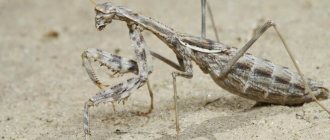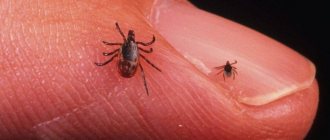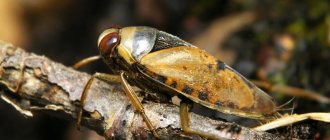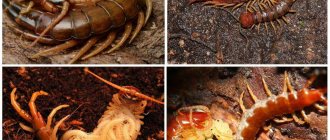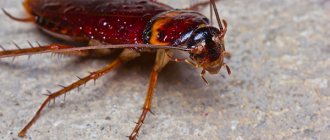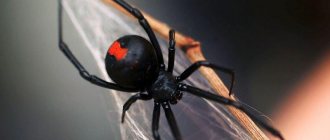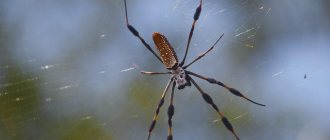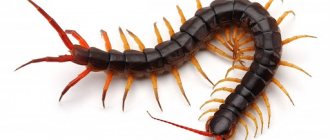The mobile bright orange beetle is called the “red soldier beetle” in England; in Russia it is known as the red beetle (umbrella). The insect of the Cantharidae family is distinguished by a soft body cover. Despite their own vulnerability, adult beetles and larvae are ruthless predators. Their victims are small invertebrates, flies, and aphids. The softshell repeatedly attacks its prey, biting until it dies. Adults expand their diet by eating flower petals and pollen.
Firefighter beetle: appearance and description of the species
The fireman beetle, red-legged soft beetle or country soft beetle (Cantharis rustica) is a species of soft beetle that has a slightly flattened body and a rather remarkable appearance. The insect grows up to 1.5 cm. The body of the firefighter beetle consists of seven joints. On the pronotum, the first segment of the red body, there is a black spot, the beetle's wings are dark gray, and the abdomen is red.
The beetle's body is covered with hairs and its legs have claws.
There is a pair of thread-like antennae on the head. They consist of eleven joints. There is a dark spot at the top of the head; it is a characteristic feature of the fire beetle.
Why is the fire beetle called that? The insect earned this name due to its black and red color, somewhat reminiscent of a fire engine.
The firefighter beetle is often called by another name - “red-legged soft beetle”, because its elytra do not have a hard chitinous covering, instead they are soft and flexible.
The lifespan of insects is short; they begin to mate at the age of one month, and after that they die quite quickly.
Beetles have pronounced sexual dimorphism: the female is much larger than the male.
Despite the fact that beetles do not have a chitinous covering, they are not as harmless as they seem at first glance. The tissues of this insect contain cantharidin, a toxic substance that protects the beetle from natural enemies. The red color serves as a warning to birds, frogs and other animals that might try to eat the beetle.
origin of name
Of course, the main feature due to which the red-legged soft beetle began to be called the fireman beetle is the color of the beetle. Most often, the insect has black elytra, red legs and body. Its body reaches approximately 20 mm in length, while it is flattened and soft, and the head is retracted into the body.
Such an unusual coloring, complemented by a characteristic dark spot near the beetle’s head, is associated by many with the uniform of firefighters. Therefore, the alternative name of the soft-bodied animal stuck among the people.
How do fire beetles reproduce?
In mid-summer, around July, insects begin their mating period.
After mating, the female lays eggs in a soft substrate, for example, in leaf litter, rotten branches, rotting stumps, boards, etc. Soon the female and the male die.
After 15-20 days (depending on weather conditions), larvae emerge from the eggs. The larvae are shaggy, dark in color and covered with dense hairs.
Fire beetle larvae, like adults, are predators and have extraintestinal digestion. The beetle's caterpillars find the victim, inject their food juice into it - a special substance, under the influence of which the tissues of the victim's body begin to dissolve. The larva then sucks in its liquid entrails.
By winter, some of the larvae pupate, while others hide in rotten wood or rotten leaves. The pupation stage lasts about two weeks. Then young beetles emerge from the pupae.
Paleontology
More than 50 fossil species of soft-bodied animals have been discovered. The oldest forms of Cantharidae were found in the Early Cretaceous in Lebanese amber (about 130 million years old), Burmese amber (about 100 million years old) and Spanish amber (about 110 million years old)[6].
- Cretaceous Katyacantharis zherikhini Kazantsev & Perkovsky, 2019 (90 million years)[7]
- Ornatomalthinus elvirae Poinar & Fanti, 2016 (97-110 Ma)[8]
- Myamalycocerus vitalii Fanti & Ellenberger, 2016 (97-110 Ma)[9]
- Archaeomalthodes rosetta Hsiao et al., 2016 (97-110 Ma)[10]
- Elektrokleinia picta
Ellenberger & Fanti, 2022 (100 Ma)[11]
- Lithocantharis lunglokshuiensis Lin, 1997 [66-56 Ma], Peng Chau Island, Lung Lok Shui (Hong Kong)
Dominican amber
- Tytthonyx geiseri Poinar & Fanti, 2016 [from 45-30 Ma to 20-15 Ma - Eocene or Miocene]
Baltic amber
- Cantharis nigricans Burmeister, 1832 [38/37.2-33.9 Ma]
- Cantharis sucinonigra Kuśka, 1992 [38/37.2-33.9 Ma]
- Cantharis sucinokotejai (Kuśka, 1996) [38/37.2-33.9 Ma]
- Electronycha prussica Kazantsev, 2013 [38/37.2-33.9 Ma]
- Ragonycha kryshtofovichi (Yablokov-Khnzorian, 1960) [38/37.2-33.9 Ma]
- Rhagonycha sucinobaltica Poinar & Fanti, 2016 [38/37.2-33.9 Ma]
- Sucinocantharis baltica Kuśka & Kania, 2010 [38/37.2-33.9 Ma]
- Sucinorhagonycha kulickae Kuśka, 1996 [38/37.2-33.9 Ma]
- Themus pristinus Kazantsev, 2013 [38/37.2-33.9 Ma]
- Cacomorphocerus cerambyx Schaufuss, 1892 [38/37.2-33.9 Ma]
- Cacomorphocerus jantaricus (Kuśka & Kania, 2010) [38/37.2-33.9 Ma]
- Macrocerus sucinopenninus (Kuśka & Kania, 2010) [38/37.2-33.9 Ma]
- Malthinus danieli Kuśka & Kania, 2010 [38/37.2-33.9 Ma]
- Malthodes ceranowiczae Kuśka & Kupryjanowicz, 2005 [38/37.2-33.9 Ma]
- Malthodes kotejai Kuśka & Kupryjanowicz, 2005 [38/37.2-33.9 Ma]
- Malthodes serafini Kuśka & Kupryjanowicz, 2005 [38/37.2-33.9 Ma]
- Malthodes sucini Kuśka & Kania, 2010 [38/37.2-33.9 Ma]
- Mimoplatycis notha Kazantsev, 2013 [38/37.2-33.9 Ma] - also in Rivne amber
- Curche pauli Alekseev & Kazantsev, 2014 [38/37.2-33.9 Ma]
- Electrosilis minuta Kazantsev, 2013 [38/37.2-33.9 Ma]
Rivne amber
- Malthodes perkovskyi Kazantsev, 2010 [38/37.2-33.9 Ma]
- Malthodes rovnoensis Kazantsev & Perkovsky, 2014 [38/37.2-33.9 Ma]
Florissant (USA)
- Atalantycha humata (Wickham, 1913) [37.2-33.9 Ma]
- Ragonycha hesperus (Wickham, 1914) [37.2-33.9 Ma]
- Podabrus cupesoides Wickham, 1917 [37.2-33.9 Ma]
- Podabrus florissantensis Wickham, 1914 [37.2-33.9 Ma]
- Podabrus fragmentatus Wickham, 1914 [37.2-33.9 Ma]
- Podabrus wheeleri Wickham, 1909 [37.2-33.9 Ma]
- Chauliognathus pristinus Scudder, 1876 [37.2-33.9 Ma]
- Trypherus aboriginalis Wickham, 1913 [37.2-33.9 Ma]
- Polemius crassicornis Wickham, 1914 [37.2-33.9 Ma]
What do fire beetles eat?
These insects are predators; firefighter beetles feed on all insects that are smaller than them, as well as those that have a soft body, since the firefighter beetle is not able to bite through the chitinous layer. Its diet includes: aphids, leaf beetles, small chafers, sleepy flies, caterpillars and larvae.
The red-legged soft calf tracks its prey from a flight altitude, then it lands on it or next to it. Afterwards, the insect bites through the victim, injects poison and digestive juice into it, after which the insides of the victim become soft, and the beetle drinks them.
In rare cases, the firebug may eat leaves and flower petals.
The larvae feed on centipedes, grubs and small worms.
Interaction with people
In most cases, red soft beetles are beneficial insects. Throughout the summer, they destroy garden and vegetable pests, as well as their eggs and larvae. Beetles are able to cleanse the house of such unpleasant neighbors as cockroaches. The softies themselves do not penetrate human habitation; they will have to be caught and brought indoors. During the dry season, when the beetles multiply significantly, they damage the buds of berry and fruit crops. Adults always feed on pollen and flowers of plants, but in small numbers their influence is unnoticeable.
Are fire beetles dangerous for humans?
Insects are predators with strong jaws, so fire beetles can bite a person, and such a bite is quite painful.
Despite this, beetles are useful because they help in pest control. If there are a lot of beetles, caterpillars or other insects in the garden that are part of the firebug's diet, then it can help reduce their population.
By the way, beetles were even used to fight cockroaches in the past. It was enough to release a few firefighter beetles into the house, and soon the cockroaches left it.
Where is it distributed?
The soldier bug is widespread throughout Eurasia, northern Africa and the United States. Countries with a temperate climate are favorable for insect reproduction.
Bedbug habitat:
- under the bark of trees;
- on stumps;
- in piles of dry grass and leaves;
- at the foundations of houses, baths, gazebos and other outbuildings;
- in the fence and its foundation.
kath_gruen
disorder_vortex
entomologist_arina
During hibernation, insects are found under heaps of garbage, in humus, in trees - under the bark or in hollows.
Preventive methods
To prevent the appearance of soldier bugs, you can take the following measures:
- Planting on a cohosh plot. Translated from Latin, the plant is called black cohosh. The smell of flowers repels insects, and they try to immigrate away from it. It is convenient to plant the plant around the perimeter of the site. You can also use other plants: wormwood, mustard.
- Plant grape bushes and other cultivated plants away from alfalfa and legumes, which are especially loved by soldier bugs.
- Destruction of weeds on the site. Weed your garden in a timely manner. As the grass grows, the number of pests increases, as does the number of eggs laid. If possible, burn the grass as there may be larvae on the leaves.
- If there is a lawn on the site, the height of the grass should be as minimal as the type of cover allows.
- Do not leave heaps of garbage or fallen leaves on the site - the favorite habitats of red bugs.
- If there are rotten and old stumps, it is necessary to uproot them and burn them.
Soldier bugs reproduce quickly and can cause significant damage to cultivated plants. At the same time, they have a thin chitinous cover and a poorly developed nervous system, so they are easy to destroy. Carrying out preventive measures will protect the area from insect infestation.
Folk remedies
And therefore, the best option would still be to exterminate the soldiers using folk biological means. Among them is a soap solution prepared from laundry soap diluted in water (about 300 grams of soap is taken for 1 bucket of liquid). Spraying with this composition will help get rid of many insect pests (not only soldier bugs).
A variety of tinctures and decoctions demonstrate a high degree of effectiveness. For example, the onion broth already mentioned above. To prepare it, 200 g of husk is taken per 10 liters and all this is infused for five days. It is recommended to spray plants with onion infusion no more than once every five days.
You can also escape from the invasion of soldiers by attracting birds to your garden plot. But you need to be careful and watch that the birds and the bugs do not peck the crop.
Soldier bugs also cannot tolerate the effects of Sarepta mustard. A solution is prepared from it (a total of 100 g of dry composition is dissolved in water to a paste). Next, this mixture is stirred in a bucket of water. This solution is used for spraying garden plots.
Actually, when creating folk remedies against soldier beetles, this factor is fundamental. Natural remedies will not harm the crop, but will help drive away unwanted pest beetles from the area. You can also remove the soldier bug using:
- There is another option - dissolve wood ash in water and also treat the beds with this composition.
- Another good folk remedy against red bugs that have entered the home is wormwood. The owner of the house will only need to make a good broom from this plant and place it in the house (you can even under the bed). Both dry and freshly harvested wormwood are suitable for expelling pests.
- An excellent way for those who are looking for how to get rid of red-black bugs that have penetrated inside the house would be to treat baseboards, plinths, and bed feet with vinegar or kerosene.
- One cannot help but recall camphor oil and turpentine. You can find these drugs in any pharmacy, and it is recommended to treat the same baseboards and bed legs with them (since soldier bugs most often move on such surfaces, at the bottom of the room).
There are a number of preventive measures aimed at preventing the penetration of soldier bugs into garden crops. Many gardeners note that these pests of cabbage, dill, parsley and other greens settle on alfalfa and legume residues in the winter. Therefore, it is recommended to plant useful crops as far as possible from these types of vegetation.
Reasons for appearance
The main reasons for the appearance of soldier bugs on the site include:
- rotten stumps in the garden;
- dried plants;
- piles of dry garbage and leaves;
- a large number of weeds, especially quinoa and wormwood;
- legumes;
- woodpiles;
- alfalfa in your or neighbors’ garden;
- growing carrots, cabbage, beets, and currants on the plot.
Insects especially love alfalfa. To get rid of the larvae, you need to pull out the weed along with the roots and burn it.
All gardeners have the soldier bug
The insects often nest in legumes and alfalfa to survive the winter cold.
In some cases, bedbugs may appear in an apartment, more often in a private house. If you have indoor flowers, seedlings or other vegetation, insects will multiply very quickly. There is a tendency that when one soldier appears, other relatives come running after him. In the absence of food, they die or go to other places.
